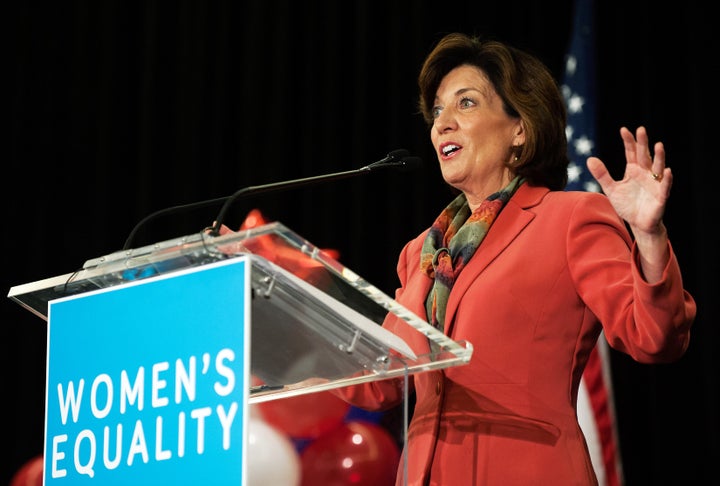Before New York Gov. Andrew Cuomo (D) faced six accusations of sexual misconduct in recent weeks, he was fond of painting himself as a feminist icon.
Cuomo called on numerous elected officials to resign when they were accused of sexual harassment ― a standard to which he apparently does not hold himself.
And while trying to express solidarity with women facing possible restrictions on abortion rights under then-President Donald Trump, Cuomo declared in January 2017, “I am a woman seeking to control her body.”
But a long-forgotten bit of theatre that Cuomo employed in 2014 may be the most remarkable instance of him using women’s rights as cover for rank political games.
As Cuomo ran for re-election for the first time in 2014, the left-wing New York Working Families Party openly debated refusing to endorse him in favor of his progressive challenger, law professor Zephyr Teachout.

With help from then-New York City Mayor Bill de Blasio, Cuomo quashed the WFP’s would-be revolt, securing the group’s endorsement on his way to a big victory against Teachout in the Democratic gubernatorial primary.
Then, in typical Cuomo fashion, he began a yearslong crusade to wipe out the WFP as punishment for their dissension.
To that end, Cuomo’s allies, including then-running mate Kathy Hochul, founded a new political party called the Women’s Equality Party in July 2014.
Hochul cast the group as a way to beat up on Republicans for opposing women’s abortion rights.
But critics immediately noticed something different. The acronym from the Women’s Equality Party was the WEP ― awfully similar to Cuomo’s nemesis, the WFP.
The WFP, which endorsed Cuomo’s challenger Cynthia Nixon in 2018, maintains that Cuomo wanted to confuse voters who might be inclined to vote for the WFP.
“There’s no question the governor created the WEP to siphon votes away from the Working Families Party,” said Monica Klein, a spokesperson for the New York WFP.
The advent of the WEP created particular challenges for some candidates for the state legislature because of New York’s unique “fusion” ballot voting system.
In New York, candidates for public office can seek to run on the ballot line of multiple political parties. It’s a system that allows conservative voters to vote for some conservative Republican leaders on the Conservative Party ballot line without directly supporting the GOP, and progressive voters to vote for some progressive Democratic leaders without directly supporting the Democratic Party.
As a result, the smaller third parties can demonstrate their influence as ideological factions within the larger two parties based on how many voters cast ballots on their ballot line.

But when the WEP came around, it meant that Democratic candidates in tight races needed to collect thousands more signatures to obtain ballot line status for yet another minor party.
In districts where margins were expected to be tight, just a few voters could make the difference ― so getting a place on the new ballot line would be essential.
Then-state Sen. Cecilia Tkaczyk was one candidate who found herself scrambling to get on the WEP ballot line in 2014.
Tkaczyk, a sheep farmer and artisanal wool maker, had won her Republican-leaning Albany-area seat in the 2012 election by just 18 votes.
Cuomo’s aides assured Tkaczyk that they would help her get the 3,000 signatures needed to get on the ballot line. But many of the signatures they helped her collect were invalid because the signers were from places like the Bronx and Brooklyn, rather than her upstate district. Republicans challenged her signatures and succeeded in getting her kicked off the ballot line.
Tkaczyk went on to lose her re-election bid in 2014 by 11,000 votes.
Referring to the creation of the WEP, Tkaczyk told HuffPost, “The real intention was not to support women like me. I wasn’t part of the plan.”
Tkaczyk likely would have lost her re-election bid even if she had been on the WEP ballot line. Cuomo received just over 1,000 votes on the WEP ballot line in Tkaczyk’s state Senate district. Even if every one of those voters would have been additional votes for Tkaczyk if she were on the ballot line, she would have fallen short.
Tkaczyk had other reasons to doubt Cuomo’s commitment to advancing women’s rights, however.
“To him, it was a political ploy, a political game and he controlled every part of it.”
- Cecilia Tkaczyk, former New York state senator
Democrats in the legislature had long wanted to enshrine federal abortion rights into state law and pass other feminist legislation. But Republican control of the state Senate continually stopped them ― and Cuomo seemed, at best, noncommittal about helping Democrats retake the state Senate.
In 2012, Cuomo allowed state Senate Republicans to gerrymander their own districts, even as Republican governors across the country were drawing districts to favor the GOP as well. He could have vetoed their plan, but he signed it instead.
In addition, around the same time Tkaczyk won her upset victory in 2012, the Independent Democratic Conference, a small group of conservative Democrats in the state Senate, was hammering out a power-sharing agreement with the chamber’s Republicans.
Tkaczyk’s win ensured the Democrats a one-seat numerical majority in the state Senate, notwithstanding the pro-GOP gerrymandering. But in a pattern that would repeat itself on at least one other occasion over the next five years, the IDC and another renegade Democratic state senator, Simcha Felder, would deprive the party of control by aligning with Republicans.
Cuomo reportedly gave the IDC’s formation his private blessing. At the very least, he had the political power to nudge them back into the mainstream Democratic fold, but chose not to do so until April 2018 as he prepared to face down a more robust primary challenge from Cynthia Nixon.
What’s more, in order to earn the New York WFP’s endorsement in 2014, Cuomo promised to campaign for vulnerable state Senate Democrats.
Tkaczyk told HuffPost that the governor did nothing significant to help and seemed irritated that she had won in the first place. During a 2013 meeting of upstate lawmakers in Syracuse where Cuomo made a surprise appearance, Tkaczyk recalls him going around the room and complimenting every lawmaker there except her, whom he ignored.

“He went down the row and talked glowingly about every senator, skipped over me, and kept going,” she said, noting that she was seated between two Republicans.
The entire experience affirmed for Tkaczyk what many female lawmakers, journalists and activists have since echoed: that Cuomo uses women’s rights and feminist rhetoric as a sword against enemies and a shield against critics, rather than because he is sincerely committed to the cause.
As Rebecca Traister noted in New York magazine, Cuomo’s top aide Melissa DeRosa pointed to Cuomo’s work to “further women’s rights, to expand protections for women in the workplace, maternal health, reproductive health” as a response to the sexual harassment allegations against him.
After Tkaczyk’s re-election loss in 2014, she decided to take a page out of Cuomo’s book and play a petty game of her own.
Chatting with her girlfriends one night over glasses of wine, she plotted to try taking over the WEP to troll Cuomo.
“For a guy to start a political party called the Women’s Equality Party was just absurd,” she said.
Tkaczyk figured out that a majority of the WEP’s candidates had had to sign off on the party’s rules. But only two out of the four WEP candidates from the 2014 election cycle signed off: Cuomo and Hochul.
So in August 2015, Tkaczyk submitted a new set of party rules that made her chair of the party. She told Politico at the time that she was “making sure women are running” the Women’s Equality Party. (While the party’s treasurer was a woman, Tkaczyk noted that candidates seeking endorsements from the party were instructed to contact Cuomo’s office.)
“To him, it was a political ploy, a political game and he controlled every part of it,” Tkaczyk told HuffPost.
Initially, a state Supreme Court judge sided with Tkaczyk, but Cuomo’s allies won on appeal and she decided to stop pursuing the matter.
Over the course of its brief existence, the WEP appeared to be best known for spawning a campaign bus with pink streaks on it with which Cuomo and Hochul, now his lieutenant governor, could tour the state.
Cuomo financed the party with loans from his campaign accounts, and the skeletal “party” ordered its priorities accordingly. Endorsing Cuomo allies took precedence over endorsing women, according to a May 2018 report in The New York Times. For example, the WEP endorsed DuWayne Gregory over Liuba Grechen Shirley in the Democratic primary to take on then-Rep. Peter King in a Long Island district in 2018. Shirley made history when she successfully petitioned the Federal Election Commission to allow her to use campaign funds to pay for child care, but Gregory, a Suffolk County legislator, came recommended by the WEP’s “state committee person.” (Shirley ultimately won the nomination and lost to King in the general election.)
In the end, the WEP went out with a whimper after just three election cycles. Cuomo received fewer than 50,000 votes on the WEP ballot line in the 2018 general election. In accordance with state law, the poor showing cost the party its place on the ballot. No one has tried to revive the party since.
Given her own experiences with Cuomo’s pettiness, Tkaczyk was not surprised to learn that Cuomo is accused of coming on to female staffers.
“He doesn’t do anything that’s not intentional. That’s my experience with his behavior,” Tkaczyk said. “The WEP is an example of that behavior. It was an absurd thing to do and yet he did it.”
But she takes no pleasure in the scandal, even if it eventually forces Cuomo to be held accountable for his actions.
“I’m really disturbed that this is what it takes, because this is harming women,” she said. “I’m not joyful at all.”

